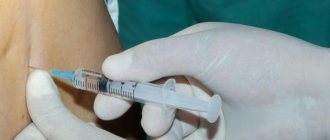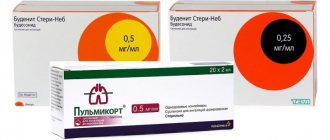Kenalog®
The drug is not intended for intravenous, intradermal, intraocular, epidural or intrathecal use. Serious adverse events have been reported with epidural and intrathecal routes of administration.
To prevent tissue atrophy at the site of intramuscular injection, the drug should be administered deep into the gluteal muscle.
The drug has a therapeutic effect for a long period of time after administration, however, it is not intended for use in emergency situations.
When using the drug topically, it is necessary to evaluate its compatibility with simultaneously administered local anesthetics.
It is allowed to mix with an equal volume of solutions of local anesthetics (1% procaine solution or 1% lidocaine solution) in a syringe, but not in an ampoule.
Before and during GCS therapy, it is necessary to monitor a general blood count, glycemia, and the content of electrolytes in the blood plasma.
With long-term use of GCS, the risk of developing subcapsular cataracts and glaucoma increases, sometimes with damage to the optic nerve. The incidence of secondary eye infections may also increase.
It is necessary to study the synovial fluid in each joint to exclude a septic process. A significant increase in pain, accompanied by local swelling, further limitation of joint mobility, fever and malaise, suggests the development of septic arthritis. If sepsis is confirmed, appropriate antimicrobial therapy is necessary. When treating during intercurrent infections, septic conditions, tuberculosis, antibiotic treatment is carried out at the same time.
It should not be injected into “unstable” joints, in the area of the Achilles tendon (risk of rupture).
Vaccination with live viral vaccines is contraindicated during GCS therapy. Immunization with killed viral or bacterial vaccines during the use of GCS does not provide the expected increase in the number of antibodies and does not provide the expected protective effect. Therefore, such drugs should not be prescribed 8 weeks before and 2 weeks after vaccination.
In patients who have not had chickenpox and are receiving treatment with corticosteroids, the risk of developing chickenpox or herpetic infection increases due to accidental contact with infected persons. In such cases, passive immunization is recommended. Caution is necessary in patients after surgery and bone fractures, since glucocorticosteroids can slow down the healing of wounds and fractures due to increased excretion of calcium from the body.
The effect of GCS is enhanced in patients with liver cirrhosis or hypothyroidism.
The use of Kenalog may alter hypersensitivity tests.
GCS can mask some signs of existing infectious diseases, as well as the appearance of infection during treatment. When taking them, there may be a decrease in immunity and a weakening of the process of localizing the infection.
The use of GCS can provoke a worsening of the condition and increased migration of larvae in patients with strongyloidiasis, which can lead to severe enterocolitis and death due to gram-negative septicemia.
When using GCS (especially high and medium doses of hydrocortisone and cortisol), increased blood pressure, fluid and salt retention, and increased potassium excretion may be observed. Although these phenomena are less pronounced when prescribing synthetic corticosteroids (such as the drug Kenalog), however, limiting salt in food and additional intake of potassium supplements may be required. With long-term use of the drug, it is necessary to ensure sufficient consumption of protein foods necessary to maintain the nitrogen balance of the body.
If a patient has a gastric ulcer, its exacerbation during treatment with corticosteroids may be asymptomatic until the ulcer perforates or bleeding begins. Considering also the fact that long-term use of corticosteroids causes increased acidity of gastric juice, which can lead to the formation of gastric ulcers, an appropriate treatment regimen for peptic ulcer should be prescribed.
In children during the growth period, GCS should be used only according to absolute indications and under the particularly careful supervision of the attending physician.
When treating GCS, menstrual irregularities may occur. Due to the risk of developing severe allergic reactions (up to anaphylactic shock) during parenteral administration of GCS, special care should be taken when treating patients with a history of allergies.
This medicine contains benzyl alcohol, which can cause serious side effects (including death), especially in children. This should be taken into account when prescribing high doses of Kenalog and long courses of treatment to patients (especially children).
Pharmacological properties of the drug Kenalog 40
A long-acting aqueous suspension of triamcinolone acetonide, intended for systemic and topical use. Triamcinolone is a synthetic corticosteroid with pronounced anti-inflammatory, antiallergic, antipruritic and immunosuppressive activity. It does not cause sodium and water retention in the body, its diabetogenic effect is 2–3 times less pronounced than that of dexamethasone. The inhibitory effect of triamcinolone on pituitary function is somewhat less than with the use of other corticosteroids. Kenalog 40 has a prolonged effect that can last for several weeks. After a single intramuscular injection at a dose of 80–100 mg, suppression of the function of the adrenal cortex is observed for 24–48 hours, which gradually disappears over 20–40 days. After intra-articular administration, 58–67% of triamcinolone is resorbed within 3 days. Metabolized in the liver. Less than 15% is excreted unchanged in the urine.
Interactions of the drug Kenalog 40
Weakens the effect of anticoagulants, reduces the concentration of salicylates and increases the level of glucose in the blood plasma (dosage adjustment of insulin or oral hypoglycemic drugs is necessary). Concomitant use of triamcinolone and diuretics may increase potassium excretion (in patients with hypokalemia, sensitivity to cardiac glycosides increases). Co-administration of beta-adrenergic blockers increases the risk of hypokalemia. Estrogens can reduce the metabolism of GCS. Concomitant administration of barbiturates, phenytoin or rifampicin reduces the effectiveness of triamcinolone. Triamcinolone used concomitantly with NSAIDs increases the risk of gastrointestinal bleeding. GCS reduce the effectiveness of antihypertensive drugs.
Contraindications to the use of the drug Kenalog 40
Hypersensitivity to triamcinolone or to other components of the drug, peptic ulcer of the stomach, duodenum or anastomosis, diverticulitis, glaucoma, diabetes mellitus, osteoporosis, psychosis, lymphadenitis after BCG vaccination, a period of 2 months after vaccination with live viral vaccines, myasthenia gravis, tuberculosis, viral infections , systemic mycosis, bacterial infections (without adequate antibiotic therapy), amebiasis, Cushing's syndrome, severe injuries and surgical interventions, vascular thrombosis and thromboembolism, age up to 6 years.
Use of the drug Kenalog 40
IV administration is contraindicated! Dosing is individual. Adults are usually administered intramuscularly at an initial dose of 40 mg, then at a dose of 40–80 mg every 2–4 weeks, depending on the clinical situation. If necessary, the dose is increased to 120 mg per 1 administration. For children aged 6–12 years, 0.03–0.2 mg/kg is administered intramuscularly at 1–7 day intervals. When administered intra-articularly, it is used in a dose of 10–40 mg. The total dose when administered into several joints simultaneously should not exceed 80 mg. Further intra-articular injections are carried out after 3-4 weeks, depending on the clinical situation. When administered into the lesion, the dose is 10–40 mg.
Side effects of the drug Kenalog 40
Side effects of triamcinolone acetonide are similar to those of other corticosteroids. Skin: stretch marks, acne, petechiae, ecchymoses, telangiectasia, pigmentation, delayed wound healing. Musculoskeletal system: muscle weakness and atrophy, osteoporosis with an increased risk of fractures, aseptic bone necrosis, growth inhibition in children and adolescents. Organ of vision: glaucoma, cataract. Digestive tract and liver: dyspeptic symptoms, nausea, anorexia, steroid gastric ulcer, pancreatitis. Endocrine system: suppression of the adrenal cortex, Cushing's syndrome, steroid diabetes, impaired secretion of sex hormones (dysmenorrhea, impotence, hirsutism), weight gain. Immune system: immunosuppression with an increased risk of developing infections, masking the symptoms of a developed infection, rarely allergic reactions. Blood system: increased tendency to thrombosis. Cardiovascular system: hypertension (arterial hypertension) . CNS: dizziness, headache, increased intracranial pressure, psychosis, depression.
Analogs
Other glucocorticosteroid hormones that are used systemically include:
- Betamethasone. The active substance is betamethasone, which also belongs to the group of corticosteroid hormones. Available in the form of an injection solution with a concentration of 4 mg/ml. The therapeutic effect is the same as that of Kenalog.
- Betaspan. Ukrainian analogue, which is produced on the basis of betamethasone. It often becomes the drug of choice among patients due to its affordable price.
- Diprospan. Hormonal drug produced in Switzerland. Available in the form of a suspension, which is administered intramuscularly. The active ingredient is betamethasone. The spectrum of action is the same as that of Kenalog.
- Loracort. Manufacturer: Iran. As an auxiliary component it contains sodium bisulfite, which can cause additional allergic reactions.
- Betaspan Depot. Contains a highly soluble form of betamethasone, which is quickly absorbed from the injection site. This leads to a faster onset of therapeutic action. In addition, it contains a second component - a slightly soluble form, due to which the absorption of the hormone occurs slowly and provides a long-lasting therapeutic effect. Not suitable for mixing with local anesthetics.
- Hydrocortisone acetate. The main active ingredient is hydrocortisone, which is why this drug is weaker than Kenalog. It is produced by different pharmaceutical companies, so it may differ in price, which allows patients to choose the most affordable product. It is not recommended to prescribe hydrocortisone to children, however, if necessary, the drug can be used from 3 years of age. Hungarian-made hydrocortisone contains lidocaine as an additional component. It exhibits not only an analgesic effect, but also acts as a membrane stabilizer. The Hungarian medicine can be administered to children from 3 months of age using the periarticular route.
- Dexon. A German drug in injectable form based on another corticosteroid hormone - dexamethasone. It has a very wide range of applications and can be prescribed in almost any branch of medicine. It can be used in children from the neonatal period under careful monitoring of the dynamics of growth and development. Dexamethasone-based drugs are produced by many pharmaceutical companies.
- Medrol. Medicine based on methylprednisolone. Available in the form of tablets of various dosages (4, 16, 32 mg), as well as in injection form under the name Depo-Medrol. Depo-Medrol is a suspension that has a wide range of applications. It can be used in children, but it should be remembered that methylprednisolone can cause irreversible growth retardation in a child of any age. Manufacturer – Belgium.


